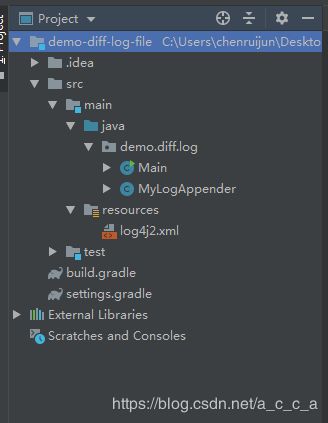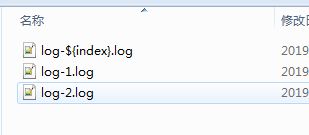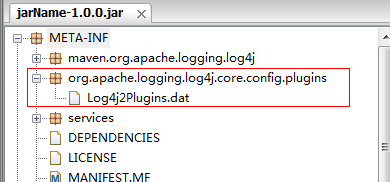log4j2 自定义日志输出文件
目的
最近用到一个项目,需要在一个类中,将日志区分打印到不同的日志文件中
比如同一个地方打印两条日志“receive message from port[123]”,"receive message from port[456]"
这两条日志的内容一样的,只不过里面的参数port不一样。
工程实现
在这里,我们使用gradle工程来实现,总体目录如下
工程的gradle.build文件
buildscript {
repositories {
maven {
url "http://179.179.179.46:8087/repository/3rd_party/"
}
}
dependencies {
classpath 'com.github.jengelman.gradle.plugins:shadow:5.0.0'
}
}
plugins {
id 'java'
}
group 'com.drama'
version '1.0-SNAPSHOT'
sourceCompatibility = 1.8
apply plugin: 'com.github.johnrengelman.shadow'
apply plugin: 'application'
mainClassName='demo.diff.log.Main'
shadowJar {
baseName = 'jarName'
classifier = null
version = '1.0.0'
}
repositories {
maven{
url "http://179.179.179.46:8087/repository/3rd_party/"
}
}
dependencies {
compile("org.apache.logging.log4j:log4j-1.2-api:2.3")
compile("org.apache.logging.log4j:log4j-api:2.3")
compile("org.apache.logging.log4j:log4j-core:2.3")
compileOnly 'org.projectlombok:lombok:1.18.6'
annotationProcessor 'org.projectlombok:lombok:1.18.6'
testCompile group: 'junit', name: 'junit', version: '4.12'
}
为了实现自定义日志输出文件,我们需要在log4j2.xml配置文件中自定义一个节点MyLogAppender
./logs
packages指定我们自定义节点对应的类的路径。
日志文件的名称中留一个变量${index},用来控制往不同日志中写不同的日志内容
然后,在工程中自定义MyLogAppender.java类,这个类只接收来着demo.diff.log.Main的日志
package demo.diff.log;
import org.apache.logging.log4j.core.Appender;
import org.apache.logging.log4j.core.Filter;
import org.apache.logging.log4j.core.Layout;
import org.apache.logging.log4j.core.LogEvent;
import org.apache.logging.log4j.core.appender.AbstractAppender;
import org.apache.logging.log4j.core.config.plugins.Plugin;
import org.apache.logging.log4j.core.config.plugins.PluginAttribute;
import org.apache.logging.log4j.core.config.plugins.PluginElement;
import org.apache.logging.log4j.core.config.plugins.PluginFactory;
import org.apache.logging.log4j.core.layout.PatternLayout;
import java.io.IOException;
import java.io.Serializable;
import java.nio.file.Files;
import java.nio.file.Path;
import java.nio.file.Paths;
import java.nio.file.StandardOpenOption;
import java.util.HashSet;
import java.util.Set;
@Plugin(name = "MyLogAppender", category = "Core", elementType = "appender", printObject = true)
public class MyLogAppender extends AbstractAppender {
private String fileName;
private Set fileCache;
public MyLogAppender(Appender appender){
super(null,null,null);
}
public MyLogAppender(String name, Filter filter, Layout layout, boolean ignoreExceptions, String fileName) {
super(name, filter, layout, ignoreExceptions);
this.fileName = fileName;
fileCache = new HashSet<>();
}
@Override
public void append(LogEvent event) {
//控制我们的输出,从输出中获取参数来判断往哪个文件中写日志
if (event.getSource().getClassName().equals("demo.diff.log.Main")) {
Object[] parameters = event.getMessage().getParameters();
if (parameters != null && parameters.length > 0) {
String index = parameters[0] + "";
final byte[] bytes = getLayout().toByteArray(event);
writerFile(index, bytes);
}
}
}
/* 接收配置文件中的参数 */
@PluginFactory
public static MyLogAppender createAppender(@PluginAttribute("name") String name,
@PluginAttribute("fileName") String fileName,
@PluginElement("Filter") final Filter filter,
@PluginElement("Layout") Layout layout,
@PluginAttribute("ignoreExceptions") boolean ignoreExceptions) {
if (name == null) {
LOGGER.error("no name defined in conf.");
return null;
}
if (layout == null) {
layout = PatternLayout.createDefaultLayout();
}
if (!createFile(fileName)) {
return null;
}
return new MyLogAppender(name, filter, layout, ignoreExceptions, fileName);
}
private static boolean createFile(String fileName) {
Path filePath = Paths.get(fileName);
Path parentPath = filePath.getParent();
try {
if (Files.exists(filePath)) {
return true;
}else {
Files.createDirectories(parentPath);
Files.createFile(filePath);
}
} catch (IOException e) {
LOGGER.error("create file exception", e);
return false;
}
return true;
}
//根据index,将日志写入到不同的文件
private void writerFile(String index, byte[] log) {
String newName = fileName.replace("${index}",index);
if(fileCache.contains(newName)==false){
//第一次往newName文件中写日志,需要先生成这个文件
createFile(newName);
fileCache.add(newName);
}
try {
Files.write(Paths.get(newName), log, StandardOpenOption.APPEND);
} catch (IOException e) {
LOGGER.error("write file exception", e);
}
}
}
之后,写一个测试类,分别往不同文件输出日志
package demo.diff.log;
import lombok.extern.log4j.Log4j2;
/**
* 直接使用 gradle shadowJar 打包即可打包出可运行的jar
*/
@Log4j2
public class Main {
public static void main(String[] args) {
log.info("I will print to log 1", 1);
log.info("I will print to log 2", 2);
}
}
这样,在输出日志的时候,就通过第一个参数来控制输出的文件
log-1.log里面打印 2019-08-13 11:39:14.512 [main] [INFO ] {Main.java:11} - I will print to log 1
log-2.log里面打印2019-08-13 11:39:14.517 [main] [INFO ] {Main.java:12} - I will print to log 2
问题与注意
问题1:log4j提示找不到MyLogAppender类
解决办法:在log4j2.xml的Configuration配置项中,增加packages="demo.diff.log"
并检查在jar文件中是否存在Log4j2Plugins.dat文件
如果不存在,需要修改build.gradle,将这个文件打包进jar,例如:
jar {
manifest {
attributes 'Main-Class': 'xxx.xxx.xxx'
}
from('out/production/classes'){
include '**/*.dat'
}
}当你在idea中直接运行一次Main函数时,log4j2Plugins.dat会自动生成到out/production/classes目录下,之后便可以使用jar打包,将这个文件拷贝到jar里面去了。在这里我使用的是shadow打包,就不需要这个步骤了。如果不是使用jar运行,而是在idea中直接运行Main函数,则只要检查out/production/classes/META-INF底下有log4j2Plugins.dat。
遗留的问题
目前使用这种方式自定义的日志输出文件,无法自动在文件内容过大的时候进行分割,如果有需要,需要自己手动分割。
或者其他人知道怎么自动分割,也可以回复一下我。



